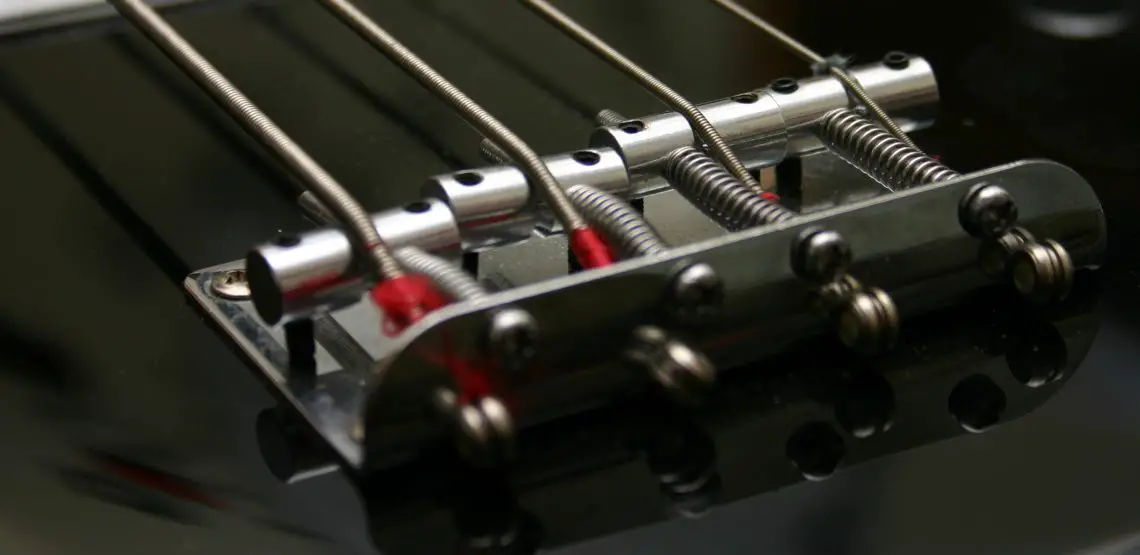Let’s be honest, there’s nothing more soulful in the music world than the dulcet tones of a bass guitar. Bass creates that thrumming sound that enhances any other instrument being played and sounds excellent when played in solos.
When you can plug into a dedicated bass amp, you can create some great sounds, but what if you don’t have an amp to plug into? This is where having an acoustic bass guitar really shines. These guitars can be played amp-less so that you can provide a bass line for a band who’s playing an impromptu gig outdoors.
This is where having an acoustic bass guitar really shines. These guitars can be played amp-less so that you can provide a bass line for a band who’s playing an impromptu gig outdoors.

Credit: Amazon.com
Top Pick: Ibanez PCBE12MHOPN
Generates some of the most resonant and easy-to-hear tones of any bass available. An open pore design allows for the instrument to reduce the distortion that can occur when you are playing it on an amplifier.
Why You Should Trust Us
There are a plethora of musical instrument reviews out there to be found on the net, but I am an actual bassist that has several years of experience under my belt. As a result of not being able to play with some of my bandmates at a cookout this past summer, I decided that I wanted a new acoustic bass.
I wanted to find a small instrument that was a lot smaller than my double bass that I could use on-the-go. I started my research in October, and I’ve pored through several unique instruments and simply found the Ibanez PCBE12MHOPN 4-String Acoustic Bass Guitar to be the best bass for my individual needs. (Speaking of unique instruments, check out these 21 weird instruments.)
Leading up to that discovery, I found several other instruments that I found excellent as well. I also consulted my friend Tom who is a fellow bassist and has a little more experience with acoustic basses than me.
To be 100 percent sure that I had a wide breadth of samples, I checked a wide variety of Amazon customer reviews, checked some on musician’s sites, and consulted a few instrument forum goers that seemed to have a handle on picking a good bass that has acoustic options as well. I was able to narrow my search down significantly.
How Acoustic Bass Guitars Are Constructed
Acoustic bass guitars are constructed in a similar fashion to most other guitars; the headstock is connected to a long fret board of varying scale length. The frets that comprise the fret board can vary; some can have as little as 15 frets and others can have as many as 26.
The bridge of the acoustic bass is located around the end of the body, and on an acoustic bass, the strings are usually adjoined to the body via string pegs.
Some acoustic basses are made from laminated wood, which is a far cheaper option for someone starting out in the acoustic bass world. The more expensive versions are the models that are crafted from solid wood. These models can go for more than $3000.
Tonewoods
Just like with any guitar, especially acoustics, the type of wood will greatly affect the tone of your music. Bass guitars, by their very nature, have a different sound than standard acoustics, but each type of guitar depends on the tonewood for its unique sound.
Each will typically use a certain combination of woods to create its signature tone; the sides and back will provide the most resonance so that your audience can hear your bass clearly, and the top will provide projection so that those audience members in the back will be able to hear you play just as clearly as those in the front row.
With this in mind, the best tonewoods for the backs and sides of your bass guitar tend to be koa, mahogany, or rosewood. If you’re looking for projecting top materials, then spruce, mahogany, and pine do as great a job on basses as they do on standard acoustic guitars.
In any situation, always keep the material of your guitar in mind because its construction will greatly affect how clear and how powerful your guitar will sound.
Composite Basses
Thanks to the miracle of technology, tonewoods aren’t the only options when you are seeking out a new acoustic bass guitar. Today, you can purchase a composite guitar that’s made of carbon fiber. This material is made by tightly weaving micrometer-wide strands of carbon fiber.
While these composite guitars are fairly new, they have a lot of advantages. Here are a few:
Durability – These are strong guitars. They won’t ding very easy and are perfect for the road. The fiber of a composite guitar is held in place by a strong resin that works with the already strong carbon to provide a tougher surface material.
Where the wood will crack under pressure and moisture, composite guitars have a tendency to ignore environmental changes. If you lead a rough and tumble life as a musician, you might want to consider a composite bass guitar.
Sound – Believe it or not, these guitars are usually much louder and resonant than a traditional wooden acoustic bass guitar. While the sound is slightly different than the tones produced by a traditional tonewood, you’ll love the sound that is produced.
Weight – As with any other application of carbon fiber, composite basses tend to be much lighter than their wood cousins. This, once again, is perfect for the traveling musician who will need to carry their guitar from gig to gig.
Acoustic Ability
There’s one thing to remember about acoustic basses; they don’t quite have the ability to produce the volume and resonance of a standard acoustic guitar.
This is partially why I had to do so much extensive research. It takes a while to find an acoustic bass that has an appropriate degree of sound, and even two instruments in the same model of acoustic bass can sound very different. Part of the reason that standard acoustics sound better is because higher tones will ring out more loudly.
This means that for you to get the same level of sound from an acoustic bass, you’ll need to purchase one with a much larger sound chamber and a wider tone hole. Many acoustic basses are the same size or bigger than jumbo acoustic guitars.
As a general rule, for the best sound, the best acoustic bass guitars will be made with a body that has a diameter that is around or above 18 inches or so. For a truly large, resonant sound, the body should have a depth that’s at least six inches.
Acoustic and Electric-Acoustic
One thing that you might notice is that many of the acoustic bass models on the market are actually electric-acoustic. This doesn’t make the guitar any less acoustic, it just means that you can plug it in when a bass amplifier is available.
Interestingly enough, the Ibanez PCBE12MHOPN 4-String Acoustic Bass Guitar is an electric-bass guitar. I made this decision consciously to play this acoustic only because I have several 4-string, 5-sting, and 6-string basses that plug in for a larger sound.
Despite its ability to be plugged in, I just wanted a model that could be used outside so that I could play with my bandmates.
In any situation, the sound differential between a hybrid electric-acoustic and a pure acoustic shouldn’t differentiate that much, but it’s always worthwhile to give a guitar a try before you purchase it.
Scale
The range of the scale of your acoustic bass usually is based on the length of the strings, which starts at the base of the bridge and extends all the way to the headstock of your acoustic bass.
The shortest range scale for an acoustic bass is usually around 30 inches long. Medium, on the other hand, is usually around 32 inches in length. Finally, a standard scale length for a guitar is around 34 inches long.
Some shorter-armed musicians prefer a 30 or a 32-inch scale, which type of acoustic bass you pick will depend on your personal preference and what is most comfortable for your specific play style.
Summation: What to Look For
Let’s run down a list of features that you should look for when searching for your brand new acoustic bass guitar:
Body Type
When in doubt, err on the side of the larger-bodied acoustic bass guitars. These will simply have a better and stronger sound output for playing without an amp.
Acoustic basses can genuinely get drowned out by acoustic guitars, so if you don’t want this to happen, go with a larger body; just don’t sacrifice comfort and ease-of-transport.
The Finish
This isn’t just an aesthetic consideration. The finish of your guitar will greatly affect its ease-of-play. Since you may be strumming with a pick, a guitar that has a smoother finish will make this slightly easier.
On the other hand, a more matte finish on your guitar won’t display accidental nicks with that same pick as obviously. In addition to this, there are aesthetic considerations as well.
It’s nice to have a guitar that matches the genre of music that you play the most, and for the most part, there are finishes that will fit most styles of music. Finally, always try to maintain the finish and seek a finish that is high quality; this will ensure the lastingness of your guitar’s overall looks.
The Neck
The neck is probably one of the most important components in a bass guitar. It not only affects your ease of play, but it also will directly affect the comfort level and the sound of your playing.
Before you pick a model, I find that a little due diligence is always advisable. Even with the instruments that we are featuring here, it’s always a good idea to try them out at your local guitar store. This way, you can decide if a guitar’s neck is too heavy for you.
To test this out, simply strap on the acoustic bass and let it dangle from the strap. If it droops towards the ground, then it might just be a bit too neck-heavy. When it comes to neck material, I prefer maple due to its excellent sound qualities.
Scale
As mentioned previously, if you have shorter arms, try out a shorter scale instrument. A friend of mine, who is also a bassist, found that her arms were a little too short to comfortably play her brand new full-scale Davidson bass.
She was able to adjust but found that she was much happier when she purchased a medium scale bass. As a matter of fact, she swears that it helped improved her playing.
Frets
How high do you want to go? This is a question that you should ask yourself because it’ll inform just how many frets your new acoustic bass guitar should have.
For the uninitiated, the higher the fret, the higher pitched the tone, so a 19 fret guitar won’t play the high notes that a 24 fret guitar can play. This is why you should select a guitar that is going to provide you the tone range that you want.
The craftsmanship of the fret pins is important as well. Sometimes, with cheaper acoustic basses, the fret pins will be a bit rough around the edges.
This can actually result in scrapes and cuts on your fretting hand, so look for a well-made fretboard that has beautiful and easy to read inlays; your hands will thank you.
The Competition
After hours of testing and research, here's the final competition.
| Instrument | Rating | Current Pricing |
|---|---|---|
Ibanez PCBE12MHOPN 4-String Acoustic Bass Guitar | Great tone wood for providing resonance and overall projection |  |
Dean EAB Acoustic-Electric Bass Guitar - Natural | Provide a well-balanced projection and resonance |  |
Ibanez AEB5EBK Acoustic Electric Bass Guitar, Black | Has enough versatility for playing genres like jazz and funk as well |  |
Fender T-Bucket Acoustic-Electric Bass | Provides some great overall projection so that those folks in the back will be able to clearly hear your notes |  |
Fender CB-100CE Dreadnought Cutaway Acoustic-Electric Bass | It really balances well with the natural wood tones of the spruce and the mahogany |  |
Ibanez Acoustic-Electric Bass Guitar | It's a multicolored hologram design that looks different in different lighting |  |
Electric Acoustic Bass Guitar | Mirror-like finish that simply makes this a very attractive bass to play in any venue |  |
Our Recommendation: Ibanez PCBE12MHOPN 4-String Acoustic Bass

Credit: Amazon.com
This is a great acoustic bass guitar. Its tone really worked for me and I loved the overall aesthetic of the instrument. This is a Grand Concert type of bass, which means that it has a larger size so that it can generate some of the most resonant and easy-to-hear tones available.
The look of the wood reminded me of the tobacco flat design of my AF55 guitar that is also produced by Ibanez. This means that the overall design of the top of the instrument features a walnut coloration that has unique whorls and lines that make the guitar look aged and well-used.
The top is actually comprised of mahogany, which is a great tone wood for providing resonance and overall projection. The sides are actually comprised of the same mahogany, which is also great for the resonance of this instrument.
The pickguard on the guitar is also great-looking, and sizeable enough to protect the main body of the instrument from picking up additional nicks and scratches from overzealous picking.
I really loved the open pore design of this instrument. This allows for the instrument to reduce the distortion that can occur when you are playing it on an amplifier.
Like the rest of the instrument, the neck is comprised of mahogany, which is a very durable tonewood that also allows this instrument to sound great when you strum.
The fret board itself has 20 frets, which means that it has more than enough range for the majority of musical genres. The fretboard is made of rosewood, so you can expect some great performance there as well.
Despite the fact that I selected this instrument strictly for its amp-less features, it does have some great powered options for when you want to plug it in. The most important of these is the built-in tuner.
On the main console of the instrument, there are several lights which tell you which key your strings are in. With this tuning system, you can quickly tune your instrument to tunings like E, Eb, or Drop D without much in the way of effort.
The Ibanez PCBE12MHOPN 4-String Acoustic Bass Guitar also uses the Ibanez AEQ202T preamp system, which actually enhances the instrument’s sound projection by a large degree. In addition to its tuning options, the console has dials for bass, treble, and volume.
While this is a bass that almost matches a dreadnought acoustic in size, you’ll find that it’s also very light and portable. The bass weighs only a little more than two pounds, so when you need to take this to a gig, you won’t have to strain on the way.
If you are looking for a bass at a very reasonable price, the Ibanez PCBE12MHOPN is a spectacular choice. Not only will you be able to play tones that are reminiscent of the Alice In Chains unplugged performance, but the actual bass tends to cost less than $250.
Runner Up: Dean EAB Acoustic-Electric Bass

Credit: Amazon.com
My runner-up was almost my top pick. As a matter of fact, it was only a last minute decision that caused me to decide that I liked the mahogany design over this guitar’s spruce top.
Another really attractive feature of this guitar is the price point; you’re not going to pay much more than 150 bucks for this instrument, which is a steal considering its quality tones and construction.
As a matter of fact, this instrument has a nearly perfect tonewood construction. As mentioned, it has a spruce top, which Dean combined with a mahogany back and sides that provide a well-balanced projection and resonance.
The neck itself is also made of mahogany, and the fretboard, like my recommended Ibanez instrument is made from rosewood. These are some very premium materials that you really wouldn’t expect to find in a guitar that goes for less than $200.
I really loved the clear and clean tone of this bass acoustic. It’s even smaller than I would have expected for such a resonant, well-projected tone. Not only is this a great guitar for a beginner who doesn’t want to spend a ton of money on a beginner’s instrument, but it’s also an excellent bass guitar for a more experienced guitarist as well.
I did also notice that the onboard electronics weren’t superb, but that’s not what I was really looking for in an acoustic bass anyway.
In the end, this is a great acoustic bass that will definitely serve the needs of about 95 percent of the bassists out there who are looking for a way to unplug and play when they want to.
Other Products to Consider:
Ibanez AEB5EBK Acoustic-Electric Bass

Credit: Amazon.com
I considered a few Ibanez guitars. This is because the Japanese company really makes a great acoustic bass. This is a medium scale instrument with a 32-inch length.
I really loved how the neck of this bass tapers to an incredible narrowness. It’s a very lightweight bass that’s very easy to take from point A to point B. If you have a shorter reach, this is a great option.
I also really loved the cutaway design of this guitar; simply put, this is one of the finest looking instruments on this list. Sound-wise, the acoustic bass has a snappy sound that is throaty and full sounding.
It has a great material construction, with a spruce top and a mahogany back and sides that deliver some great overall resonance. The tone hole is fairly large so that the bass has plenty of resonance.
When I played it, I loved the overall warmth that was inherent in its tones, this is definitely a great instrument for folk and country, but it has enough versatility for playing genres like jazz and funk as well.
I also liked the fact that Ibanez included two output jacks in the design of this acoustic. It has a standard bass amp jack and a jack for an XLR PA system.
Aesthetically, I mentioned that the overall design of this guitar is fine, but its finish is amazing. The instrument is black and has a mirror-like finish that’s incredibly attractive.
Fender T-Bucket Acoustic-Electric Bass E

Credit: Amazon.com
Fender is the producer of some of the most iconic guitars in the industry. Their acoustic-electric guitar has a ton of great versatility and is also one of the more attractive instruments in this guide (after the Ibanez AEB5EBK of course.)
This guitar has a “flame maple top” which is simply stunning. Maple is a great tone wood, so Fender’s decision to use it in this product not only provides a beautiful look for this instrument, but it also provides some great overall projection so that those folks in the back will be able to clearly hear your notes.
For the sake of resonance, the sides and the back of this instrument are comprised of mahogany. I also really liked the Graph Tech Nubone Saddle that holds the string pegs for this instrument; they really make the guitar look even more impressive and folksy.
Despite this old-timey look, Fender included holograms in the instruments rosette, which is the design around the main tone hole of the bass acoustic.
For those looking to plug in, this bass has a Fishman Isys III System with Active Onboard Preamp and Tuner that grants a lot of options when plugged in.
You’ll find settings for treble, bass, mid, volume, and an on/off switch. Typically, you can find this Fender acoustic bass for around $300 or so.
Fender CB-100CE Dreadnought Cutaway Acoustic-Electric
Our second Fender acoustic bass is a dreadnought style guitar that’s large and projects a great amount of sound. As a dreadnought that has a full-sized 34-inch scale, this won’t be an excellent instrument for smaller folks, but if you can heft it and have the reach, then this is an excellent sounding acoustic bass.
This is a laminated acoustic bass that has a spruce top and mahogany sides like the other products that we’ve featured thus far. This means that this instrument has all of the projection and resonance that most musicians will need in order to accompany most acoustic band setups.
The fret board has 22 frets, which also gives you a nice overall range of tone. From an aesthetic point of view, I really liked the edging of this instrument. It really balances well with the natural wood tones of the spruce and the mahogany.
The deep black pickguard is also well-placed; it really works well with the overall aesthetic of the instrument. Finally, the string pegs are a bit overlarge, which you may or may not like.
Personally, I thought that this was a great looking feature for me, but at the same time, it’s not for everyone. You can expect to find this instrument for as low as $300 on sale, but on average, expect to spend about $350 before taxes.
Ibanez Acoustic-Electric Dark Violin Sunburst

Credit: Musician’s Friend
Our final Ibanez guitar has a great design that incorporates a stained spruce top and mahogany sides. The stain on the top of this instrument makes this guitar look great.
Most musicians wouldn’t recognize this guitar as spruce at all, but when you play it, the sound and projection of that tone wood are unmistakable. Tone-wise, this instrument produces notes that are warm and resonant.
Outside of its stained design, I really loved the coloration of the rosette. It’s a multicolored hologram design that looks different in different lighting. The saddle is very classic looking and its black string pegs look great while playing a gig.
Another feature that I really liked about this instrument is its pearl dot inlays. These really seemed to shine when I was playing the instrument, which really illustrates the effort in design that Ibanez seemingly has put into this instrument.
The headstock on this instrument is also probably my favorite of the bass guitars that you’ll read about in this guide. It has die-cast chrome tuners and a holographic filigreed design in its center that is really nice looking.
For those who want to plug in, you’ll be pleased to know that this guitar uses a Fishman Sonicore pickup and SST preamp that provides some great sound options when you hook it up to an amplifier.
Electric Acoustic Blue Solid Wood Construction With Equalizer

Credit: Amazon.com
Our final choice is a great-looking instrument that works exceptionally for a beginner bassist. The first thing that you might notice is this instrument’s blue coloration. This is definitely one of the key features that really attracted me to this bass.
This design is enhanced by a mirror-like finish that simply makes this a very attractive bass to play in any venue. The second feature of this bass that attracted me is its price; the bass typically costs less than $100, which makes it a perfect beginner’s bass.
The headstock of this bass is also fairly irregular, which made me really appreciate the design, though the chrome tuning pegs seemed a little cheap when I was tuning it.
Another great feature of this instrument is its built-in equalizer; as a matter of fact, for the price, the hardware on this instrument is a fairly top notch. Add to this the fact that the sides and back are comprised of resonant mahogany, and you’ve got a great acoustic bass.
Sources
- McCraw, N. (2016, December 12) Personal Interview
- Best Acoustic Bass Guitars in 2016: Comparison Reviews and Rankings(2016) Retrieved from http://bestguitar.reviews/top-acoustic-bass
- Top 10 Best Acoustic Bass Guitars Reviews (2016) Retrieved from http://www.buythebest10.com/top-10-best-acoustic-bass-guitars-reviews/
- Ebay, Acoustic Bass Guitars Buying Guide (February 15, 2016) Retrieved from http://www.ebay.com/gds/Acoustic-Bass-Guitars-Buying-Guide-/10000000178357738/g.html
- Best Acoustic Bass Guitar (Buying Guide 2016) Retrieved from http://www.guitarmesh.com/best-acoustic-bass-guitar/









Start the discussion at talk.hearthemusicplay.com